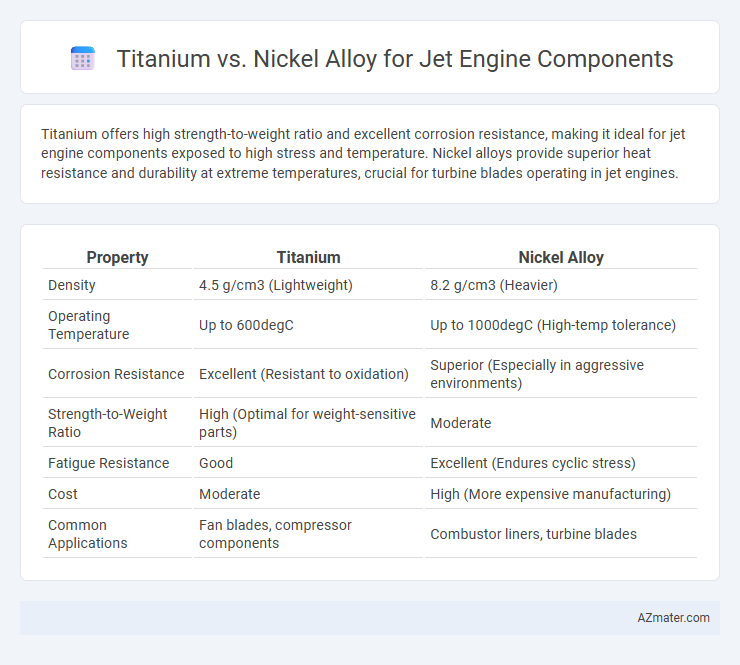Titanium offers high strength-to-weight ratio and excellent corrosion resistance, making it ideal for jet engine components exposed to high stress and temperature. Nickel alloys provide superior heat resistance and durability at extreme temperatures, crucial for turbine blades operating in jet engines.
Table of Comparison
| Property | Titanium | Nickel Alloy |
|---|---|---|
| Density | 4.5 g/cm3 (Lightweight) | 8.2 g/cm3 (Heavier) |
| Operating Temperature | Up to 600degC | Up to 1000degC (High-temp tolerance) |
| Corrosion Resistance | Excellent (Resistant to oxidation) | Superior (Especially in aggressive environments) |
| Strength-to-Weight Ratio | High (Optimal for weight-sensitive parts) | Moderate |
| Fatigue Resistance | Good | Excellent (Endures cyclic stress) |
| Cost | Moderate | High (More expensive manufacturing) |
| Common Applications | Fan blades, compressor components | Combustor liners, turbine blades |
Introduction to Jet Engine Materials
Jet engine components demand materials with exceptional strength-to-weight ratios, high-temperature resistance, and corrosion resistance to ensure optimal performance and durability. Titanium alloys offer a unique combination of low density, high strength, and excellent fatigue resistance, making them ideal for fan blades and compressor discs in jet engines. Nickel alloys, particularly superalloys like Inconel, provide superior high-temperature strength and oxidation resistance essential for turbine blades and combustion chamber components exposed to extreme thermal environments.
Overview of Titanium Alloys
Titanium alloys offer exceptional strength-to-weight ratios and corrosion resistance, making them ideal for high-performance jet engine components exposed to extreme temperatures and stresses. Their ability to maintain structural integrity at temperatures up to 600degC outperforms many nickel alloys in weight-critical applications. These properties contribute to improved fuel efficiency and engine longevity, driving widespread use in aerospace manufacturing.
Overview of Nickel Alloys
Nickel alloys are prized in jet engine components for their exceptional high-temperature strength, corrosion resistance, and creep resistance, which are critical for turbine blades and combustion chambers. These superalloys maintain mechanical integrity at temperatures exceeding 1000degC, outperforming titanium alloys in extreme thermal environments. Their complex microstructures, often stabilized by elements like chromium, cobalt, and molybdenum, ensure durability under intense mechanical stress and oxidation.
Mechanical Properties Comparison
Titanium alloys exhibit a superior strength-to-weight ratio and excellent corrosion resistance, making them ideal for jet engine components subjected to high stress and high temperatures. Nickel alloys offer exceptional high-temperature strength and creep resistance, maintaining mechanical integrity in extreme thermal environments typical of turbine sections. Comparing both, titanium alloys provide enhanced fatigue resistance and lower density, while nickel alloys dominate in thermal stability and oxidation resistance at temperatures exceeding 700degC.
Temperature Resistance and Thermal Stability
Titanium alloys exhibit excellent temperature resistance up to approximately 600degC, maintaining high strength-to-weight ratios essential for jet engine components exposed to moderate thermal environments. Nickel alloys, particularly Inconel variants, offer superior thermal stability and strength retention at elevated temperatures exceeding 900degC, making them ideal for turbine blades and combustion chambers. The choice between titanium and nickel alloys depends on specific engine zones, balancing weight considerations with the required temperature endurance and oxidation resistance.
Corrosion and Oxidation Resistance
Titanium alloys exhibit superior corrosion resistance in jet engine components due to their stable oxide film, which effectively prevents degradation in high-temperature and aggressive environments. Nickel alloys, while possessing excellent oxidation resistance at elevated temperatures, tend to form protective oxide layers that can spall under thermal cycling, impacting long-term durability. The choice between titanium and nickel alloys depends on specific engine conditions, with titanium favored for its lightweight corrosion resistance and nickel alloys preferred for high-temperature oxidation stability.
Weight and Density Considerations
Titanium alloys offer a significant advantage in jet engine components due to their lower density of approximately 4.5 g/cm3 compared to nickel alloys, which have a density around 8.2 g/cm3, resulting in substantial weight savings. The reduced weight of titanium enhances fuel efficiency and increases thrust-to-weight ratios while maintaining high strength and corrosion resistance at elevated temperatures. Nickel alloys, despite their higher density, provide superior high-temperature strength and creep resistance, often necessitating a trade-off between weight savings and thermal performance in engine design.
Cost and Manufacturing Challenges
Titanium alloys offer superior strength-to-weight ratios and corrosion resistance for jet engine components but come with higher raw material costs and expensive manufacturing processes, including complex machining and heat treatments. Nickel alloys, while heavier, provide excellent high-temperature strength and oxidation resistance with relatively lower material costs but pose challenges in casting and require precise control during fabrication to prevent cracking. Balancing cost-efficiency with performance demands involves selecting titanium for lightweight structural parts and nickel alloys for high-temperature zones.
Application Suitability in Jet Engine Components
Titanium alloys are preferred for jet engine components exposed to moderate temperatures due to their exceptional strength-to-weight ratio and corrosion resistance, making them ideal for fan blades and compressor disks. Nickel alloys excel in high-temperature regions such as turbine blades and combustion chambers because of their superior creep resistance and thermal stability above 800degC. Selecting the appropriate material depends on balancing mechanical properties, temperature exposure, and oxidation resistance to maximize engine performance and durability.
Conclusion: Selecting the Optimal Alloy
Titanium alloys offer superior strength-to-weight ratios and excellent corrosion resistance, making them ideal for high-performance jet engine components where weight reduction is critical. Nickel alloys provide outstanding high-temperature stability and creep resistance, essential for turbine sections exposed to extreme thermal stress. Selecting the optimal alloy depends on balancing operational temperature requirements with mechanical performance and cost efficiency in jet engine design.

Infographic: Titanium vs Nickel Alloy for Jet Engine Component
 azmater.com
azmater.com